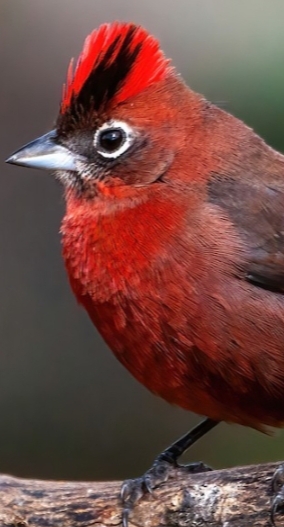Although the elegant red-crested finch was far better known to birdkeepers 30 years ago, pairs do persist in this country and GARY BRALSFORD would welcome any initiative to restore the bird’s popularity. If kept correctly, it can be relatively straightforward to breed
THE red-crested finch (Coryphospingus cucullatus), also known as the red pileated finch, was imported in good numbers during the 1990s. In recent years, by contrast, the species has almost disappeared from aviculture in the UK.
That said, there are one or two specialist breeders around who keep this species and actually breed it in good numbers. One lady breeds from two pairs and last year she produced a total of 16 chicks across both pairs. That is an excellent breeding result.
Her finches are bred in outside aviaries of about 3m x 2m x 2.5m in size. These are planted to offer privacy in general and a degree of seclusion for the nest-sites. The finches are bred on their own, with no other species sharing their quarters. They breed in wicker baskets or half-fronted nest-boxes, where they use coconut fibre and animal hair as the main elements of construction, though they will also use roots and dry grasses.
When I have kept them, I found them aggressive to other birds, and especially ones with any red in the plumage! Cock birds are the worst and will defend their territory with belligerence, even attacking the wire in their aggression towards the next-door aviary occupants.
I got mine from a bird importer in Lincolnshire, a guy who imported a lot of nice South American birds at that time. He used to bring in some rare finches and softbills, many of which may never be seen in aviculture again.
Red-crested finches remind me a lot of the little yuhina species of Asian softbills. Their crest is visible when they are excited, especially in the cock bird. He uses this crest in his display to the hen when he’s ready to breed, or as an aggressive threat to any species that gets in his way. It is a real shame that we didn’t do better with these species back in the days when imports were more readily available!

Origins and behaviour
Although called a finch, this species is now classified along with the tanagers and their allies in the family Thraupidae. It has a large range in South America, where it is found in Argentina, Bolivia, Brazil, Guyana, Paraguay and Peru. Its natural habitat ranges from dry forest to subtropical wet forest. It is apparently quite common in its range. There are three subspecies: nominate cucullatus in the north-eastern South America, rubescens to the south-east down to Uruguay and fargoi to the west of both. It is a bird of the lowlands and foothills, found up to about 5,000ft above sea level.
The species measures about 13.5cm (51/2in) long, so it’s a medium-sized finch. Both sexes show a white eye ring, but the red crest and black head are not present in the hen bird and her upperparts are browner than the cock bird. Her throat is white and her underparts pink.
In the wild, this very attractive bird appears to be doing well and populations are reported to be steady. If only we could say the same of its avicultural status. If anyone is breeding this finch, please contact the editor. A co-ordinated breeding group could share knowledge and even stock.
Gary Bralsford is best known as a specialist in softbills, though he has wide experience of numerous other exotic species too.
Find more news and articles like this on the Cage & Aviary Birds website. Subscribe to Cage & Aviary Birds magazine now.


